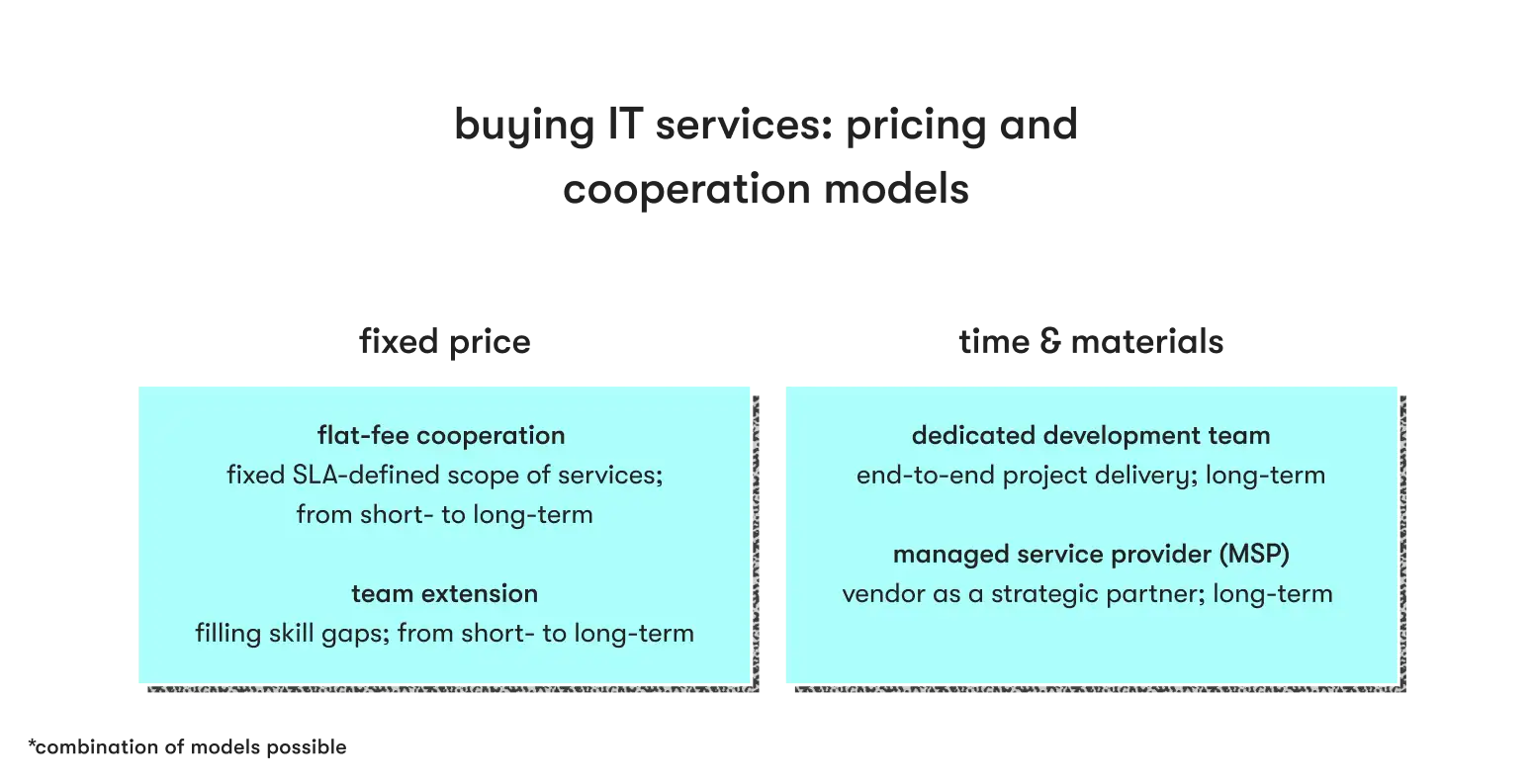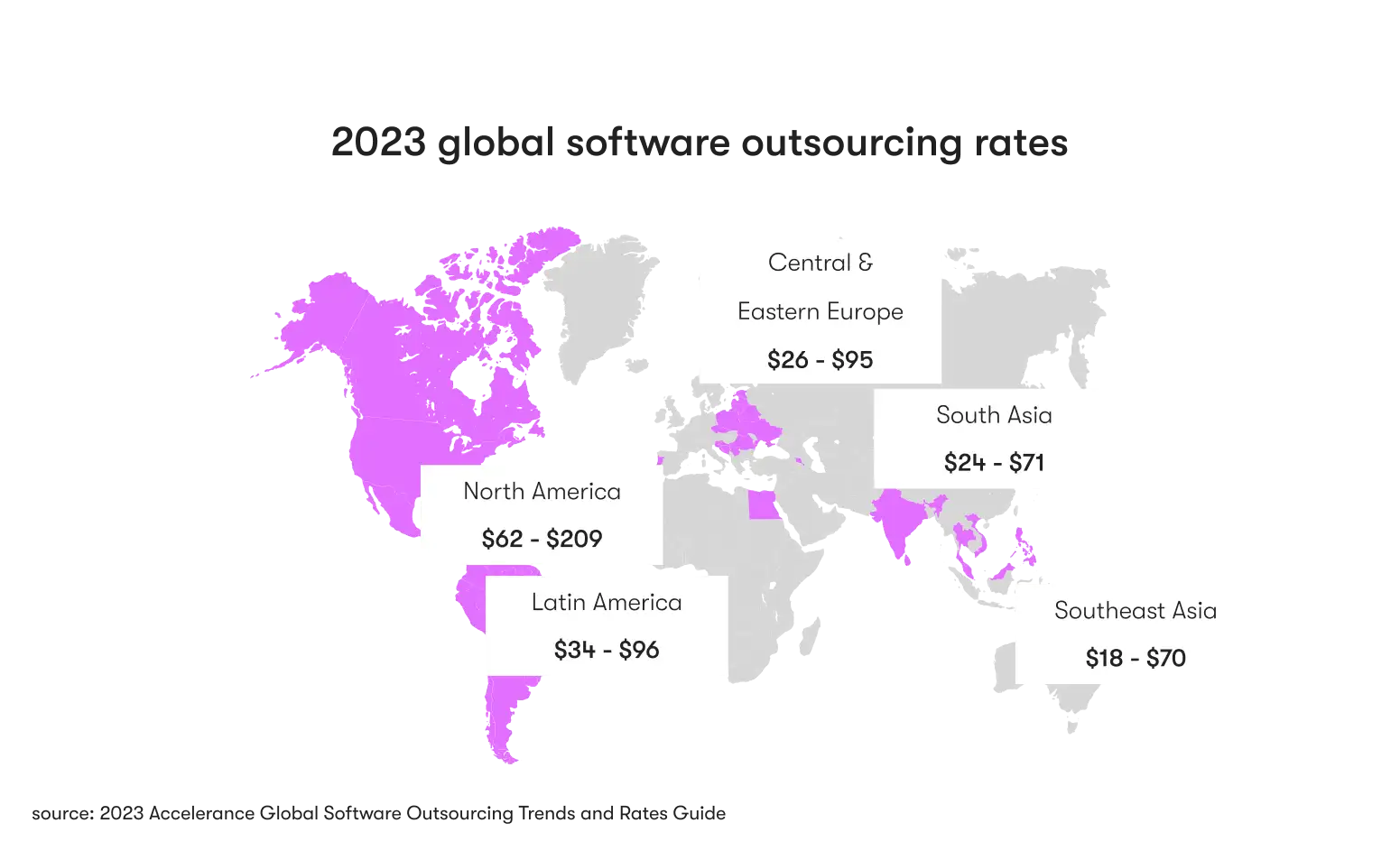IT outsourcing cost is the total expense incurred when a company delegates its IT functions and services to external providers. This includes costs related to hiring third-party vendors, project management, technology infrastructure, and ongoing maintenance and support. Understanding IT outsourcing costs is essential for budget planning and maximizing return on investment while leveraging external expertise.
While IT outsourcing services are highly convenient and enhance the capabilities of a business significantly, concerns about IT outsourcing costs make many small businesses and startups wary of moving forward. Often, they’re running on the assumption that the cost of outsourced IT services is significantly higher than having an in-house team handle the activities. In reality, that’s rarely the case.
In fact, outsourcing IT services can lead to significant cost savings if you partner with a reputable service provider. Here’s what you need to know about the costs of working with an IT outsourcing company.
Why outsource IT services
According to the Deloitte Global Outsourcing Survey, 50% of executives state that talent acquisition is a top internal challenge in meeting strategic priorities in their organizations. A talent shortage often means traditional hiring methods aren’t as effective, and that’s particularly burdensome to small and mid-sized companies with smaller IT departments.

A lack of qualified talent in the immediate area also slows the progress of startups. Typically, startups experience rapid change, particularly as they begin gaining traction. Without suitable skill sets available, startups may fail to seize unexpected opportunities that can further spur growth, causing them to miss out on profit-boosting new business or even putting them at risk of failure if they’re unable to capture necessary revenue.
Additionally, in the post-pandemic landscape, managing costs is increasingly critical to ensure profitability. According to a report released by Oracle, 78% of CFOs explore cost reduction measures to counteract inflation, and 99% of business leaders anticipate budget cuts if there’s a recession.
While small to mid-sized companies and startups see the financial side of the equation differently than large corporations, they often have a greater need to keep costs manageable. Usually, small businesses and startups have limited resources to navigate the unexpected. In turn, finding ways to keep their budget in check is essential at all times, but especially during periods of economic difficulty.
Essentially, SMBs and startups need cost-effective solutions along with greater access to critical talent. By finding a high-quality outsourcing partner, it’s easier to achieve both of these business goals.
Reasons to go for IT outsourcing
While the information above outlines why outsourcing IT services is wise, it technically only scratches the surface. Ultimately, there are many benefits of outsourcing various IT functions or securing outside talent. Typically, the most significant reason to outsource your software development or other IT needs is to save money.
When you outsource, you can often find a subject matter expert with lower salary requirements than a programmer in your area. For example, highly skilled developers from Eastern Europe are usually less expensive than similarly capable IT professionals from the United States.
In addition, you avoid additional employee-related expenses like benefits administration. It can also eliminate a variety of recruitment costs, as most outsourcing service providers handle the candidate sourcing for you.
Often, outsourcing vendors vet all professionals they find. This reduces the amount of time companies need to spend on screening candidates before making hiring decisions, giving them the ability to focus on other profit-driving activities with greater ease. However, many outsourcing providers do ensure that business owners or managers are involved in the selection process, giving them a chance to handpick a team that genuinely meets their needs.
When you examine the pros and cons of outsourcing, another critical point to consider is the quality of the available information technology services. A leading IT service provider is diligent about vetting professionals and elevates their capabilities by providing necessary tools and training. As a result, the chosen team members typically meet or exceed performance expectations, increasing a company’s odds of a positive outcome.
A reputable outsourcing service provider also offers various guarantees. While the exact nature of these guarantees can vary, they typically ensure that you get the promised IT support within the outlined timeframe. Further, they usually give you the ability to rapidly change out team members if you’re ever dissatisfied with a professional’s performance.
Finally, when you partner with an IT outsourcing service provider, you maintain a heightened degree of agility. If your project requirements change on the go, a professional vendor will have the resources and flexibility to address them without affecting the speed of delivery.
PARTNER WITH A VENDOR THAT MEETS ALL OF YOUR REQUIREMENTS
Choose EPAM Startups & SMBs to get access to 50K+ vetted tech professionals to elevate your project with the expertise you need.
Top IT outsourcing services in demand
Specific outsourcing services are increasingly in demand. Often, those that see significant growth are related to broader challenges in the overall landscape.
One prime example is cybersecurity services. According to IBM, the average total cost of a single data breach is $4.25 million, and that cost is rising every single year. By outsourcing your cybersecurity, you can elevate the capabilities of your small business or startup, reducing the odds that you’ll become part of those statistics.
Another widely-used option for outsourcing is custom software development. Accessing skilled developers is challenging for companies of any size, but it’s particularly difficult for small to mid-sized organizations that can’t maintain a large in-house IT team financially. With outsourcing, companies can get top-tier professionals with a pricing model they can afford.
Finally, in the world of IT management, DevOps is becoming a go-to methodology. By outsourcing DevOps services, small businesses and startups can incorporate DevOps strategies into their IT environment, leading to greater efficiency and improved results.
What goes into IT outsourcing costs
To understand IT outsourcing costs, let’s first break down the multiple types of IT outsourcing options available.

First, you may find IT management or support options that rely on a basic flat-monthly fee, with the provider offering specific services based on rigid service level agreements (SLAs). Second, there are cooperative, value-driven partnerships where the vendor functions as both a managed service provider (MSP) and a strategic partner, adding agility to ensure that the outsourced team shifts and grows with you as needed to support critical business processes, spearhead emerging projects, and more.
Additionally, you can take either of the arrangements above and divide them further into team augmentation and end-to-end project delivery via dedicated development teams.
When you go for team extension, typically, core business IT needs are managed on-site by internal IT professionals, while the outsourced team members fill gaps as required to boost the cumulative capabilities of the department.
Finally, there’s the dedicated development team option. With these, the IT outsourcing partner provides everything to manage their designated area of responsibility. For clients, this can include receiving a project manager along with full-time software engineering staff. For longer-term needs, arrangements typically veer into managed service provider (MSP) territory, where you receive managed IT services to cover an operational area, such as a help desk for internal or customer technical support.
IT pricing options
There are several pricing models that are common among IT outsourcing providers. First, you have fixed-price services. These have a set, predictable price for the outlined services and essentially guarantee that you’ll receive whatever is discussed for the amount of money listed in the contract. This strategy is more common for monthly flat-fee service agreements.
Next, there are time and materials-based pricing options. These are less rigid, as pricing depends on the exact services rendered and the time required to complete the work. However, they also offer enhanced agility, as the contract may not limit the outsourcing service provider to specific operational areas, allowing you to expand their involvement in your business whenever the need arises.
Finally, there’s the mixed-mode pricing model. Usually, this features components of a fixed-price arrangement and a time and materials-based approach. As a result, it offers some agility while still allowing for specific parameters, such as strict deadlines.
If you want to estimate your IT outsourcing costs, using our software development cost calculator is a simple way to move forward with software project cost estimation and find out how much it costs to hire software developers you need.
ESTIMATE THE PRICE OF YOUR PROJECT
Contact us to get real estimates for your software engineering project
The costs of IT outsourcing by region
Whether you’re interested in hiring developers in the UK, Canada, Australia, or elsewhere, the cost of IT outsourcing will inevitably vary.
Professionals in some countries expect a higher hourly rate than others. Often, there are several key factors that influence their expectations, with the cost of living in their part of the world being the most significant.
By looking at the average IT outsourcing costs in different regions, it’s easier to see how various parts of the world can provide value, allowing small businesses and startups to reduce their IT spending while securing top-tier skill sets. Here’s an overview of the hourly rate range typically found in different regions, based on the 2023 Accelerance Global Software Outsourcing Trends and Rates Guide:
- North America: $62 to $209 per hour
- Central and Eastern Europe: $26 to $95 per hour
- Latin America: $34 to $96 per hour
- South Asia: $24 to $71 per hour
- Southeast Asia: $18 to $70 per hour

Why IT outsourcing is still the most cost-effective option
While IT outsourcing can include planned and unanticipated costs, it’s still the most cost-effective option, particularly for small businesses and startups. IT outsourcing costs usually fall far below what it would take to hire your own in-house tech team. Plus, it alleviates the strain of recruiting in case of talent shortage.
Using outsourcing providers to hire programmers for a startup or small business also allows you to bring remote developers on board from less expensive regions. Often, these professionals are highly skilled and capable; they’re simply in an area with a lower cost of living, resulting in lower compensation expectations.
Ultimately, IT outsourcing is an affordable, flexible option that ensures you can access the talent your company needs. It also lets you effectively manage your budget, all while getting optimal results.

Anush has a history of planning and executing digital communications strategies with a focus on technology partnerships, tech buying advice for small companies, and remote team collaboration insights. At EPAM Startups & SMBs, Anush works closely with subject matter experts to share first-hand expertise on making software engineering collaboration a success for all parties involved.
Anush has a history of planning and executing digital communications strategies with a focus on technology partnerships, tech buying advice for small companies, and remote team collaboration insights. At EPAM Startups & SMBs, Anush works closely with subject matter experts to share first-hand expertise on making software engineering collaboration a success for all parties involved.
Explore our Editorial Policy to learn more about our standards for content creation.
read more




















